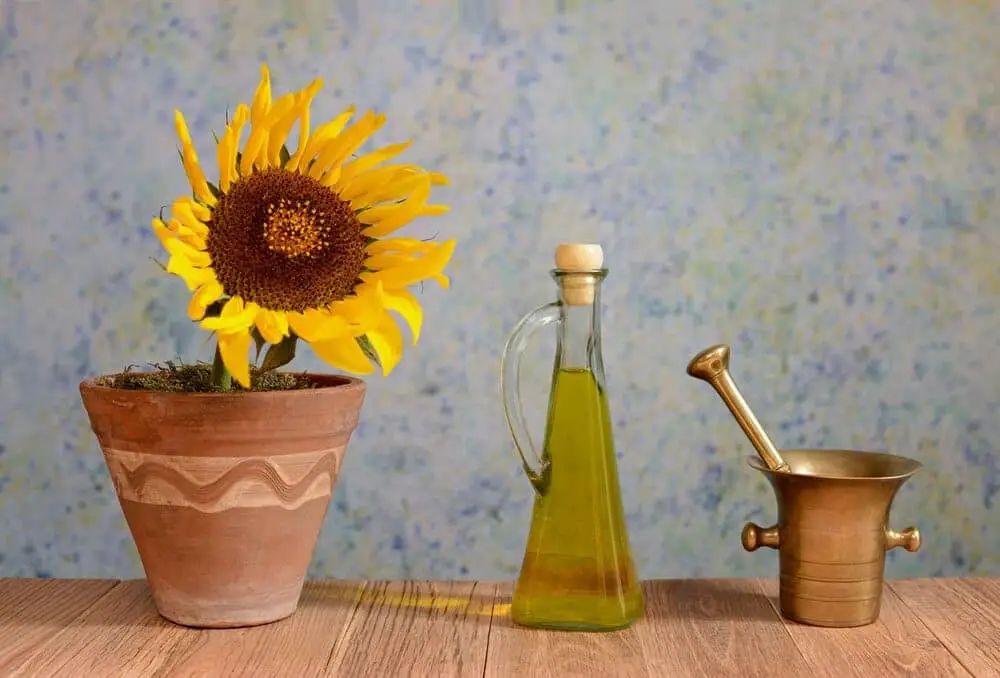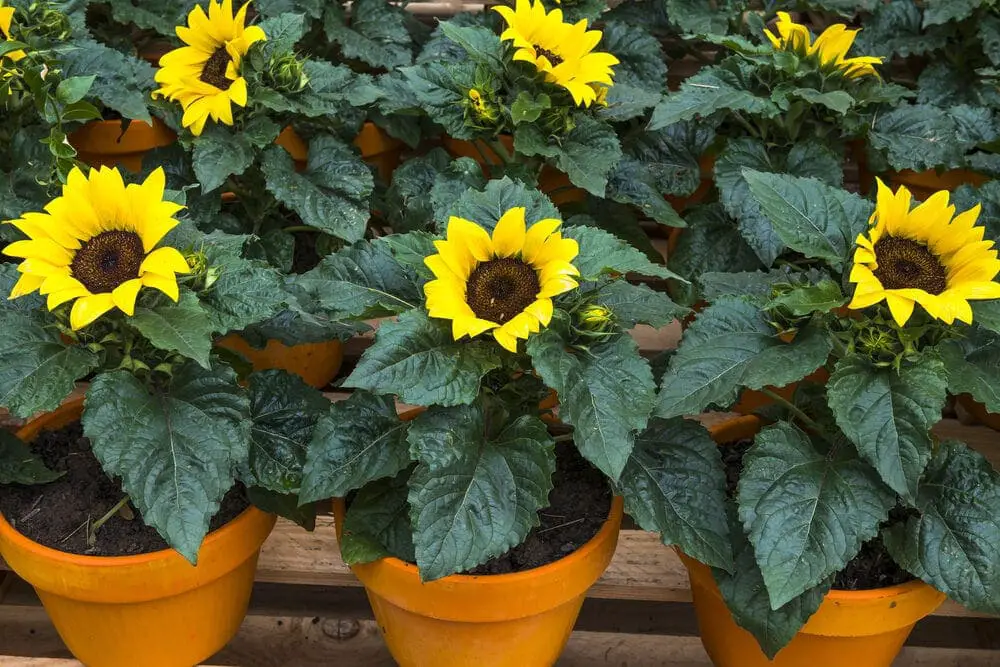Sunflower; seeing those waving in the breeze just scream summer. Planting and growing them is easy.
They are a plant that is fast-growing, heat tolerant, and pest resistant. What more could anyone ask for when growing plants? There are so many different ways in which a sunflower can be used; cut flowers, harvest them for their seeds to eat, or leave them on the stalk for a beautiful outdoor display.
Sunflowers Care & Growing Guide
1. Light Requirement
A Sunflower plant needs to be planted in an area that gets direct sun six-eight hours a day.
2. Water
When the plant is small, you should water about four inches from the plants, around the roots. Once it is an established plant, you should water it infrequently to help it grow deep roots but when watering, do it deeply. Water it once a week using several gallons of water per plant. If the weather is very dry or hot, you may need to water it more often.
They do not need to be fertilized in good soil but if the soil is poor, you could add some slow-acting, granular fertilizer to the soil.
3. Climate
USDA Hardiness Zone 2-11
4. Soil
The plant needs well-drained, loose soil because their long taproots have to go several feet into the ground. The soil should have a pH of 6.0-7.5 and be somewhat alkaline. To produce the most blooms and be healthy, the soil needs to be nutrient-rich with organic or compost mixed into the soil.

5. Temperature
When you plant your Sunflower seeds, the temperature of the soil needs to be 50-60 degrees Fahrenheit and after the danger of frost in order for the seeds to germinate.
6. Repotting
In most instances, you do not repot a Sunflower plant as most are too tall to grow in a planter. When growing them outside, you start with seeds.
7. Speed of Growth
It will take from 80-120 days from the time you plant the seeds for them to grow. How long it will take depend on the variety of Sunflower. A Sunflower plant can grow to six feet in three months.
8. Height and Spread
Some Sunflower plants will reach 14 feet tall but you can get some smaller varieties that will only be 12 inches tall and fit in a small garden or a planter for indoors.
9. Flowers
When you look at a Sunflower, they look like a giant daisy. Most are bright yellow but you can also find then in dark, burgundy reds and all shades of red, orange, and yellows in between. They have a brown center that will ripen into a head that is filled with edible seeds. The flowers bloom for several weeks mid-summer.
Sunflower plants also have a variety of petal counts. The most common is the single layer of petals but you can find some with a teddy bear or double petal layers.

10. Trimming
Most Sunflower plants do not need trimming but if you have ones that have multiple stems, you can trim those. All you do is cut the main stem before the bloom has opened, which will encourage it to make more blooms. The flowers will appear on the side of the stem.
To cultivate the seeds, let the flower dry off or on the stem until the back of the head turns brown with yellow foliage. Cut the head off the plant about six inches below the flower head. To get the seeds off, you can pull them off by hand, use a fork, or rub your hand over the seeds to get them to fall off.
You will need to rinse the seeds before you lay them out to dry overnight. You can roast them or put them in an airtight container to plant next year. If using them for replanting, put the jar in a cool, dry place.
Is Sunflower Poisonous?
They are non-toxic to humans and animals as we eat the seeds and other animals eat seeds also.
Can Sunflower grow in Water?
No, they cannot be grown in water but must be planted directly into the soil.
How to get Sunflower to Flower?
When you plant your Sunflower seeds, stagger your planting. Start a new row of seeds every two to three weeks, starting in the spring so you will have flowers up to the first frost.
Common Plant Diseases
Sunflower is prone to a variety of diseases, including:
- Fungal diseases like powdery or downy mildew or rust—to get rid of these, spray the leaves infected with a garden fungicide.
- Squirrels and birds like to eat the seeds so if you want to use the seeds, use barrier devices. You can use garden fleece after the heads mature and the flowers droop
- Deer can be kept at bay using a tall wire barrier.
Also read:
- Calla Lily Flowers Care & Growing Guide
- Hyacinth Flowers Care & Growing Guide
- Queen Of The Night Flower Care & Growing Guide
Conclusion
- The Sunflower plant attracts birds and bees who dine on their seeds and nectar.
- Their botanical name is Helianthus annuus.
- If you do decide to grow them indoors in a planter, make sure that you get one of the smaller varieties, like Teddy Bear. Be sure you have a planter large enough to accommodate the taproot.
- If you want to grow the 10-foot variety make sure they are planted away from the wind so they are not blown over.
- You can use wood or bamboo stakes to help support the weight of the Sunflower plants.
- They are heliotropic, which means that they turn their flowers to follow the movement of the sun.
- You can put out a dried Sunflower head and the birds will pull off the seeds.
- When you plant Sunflower seeds, make sure that they are planted six inches apart. They should be in a shallow trench one to two inches deep.
- When you see the second or true leave appear, you will need to thin the plants to two feet apart.
- Sunflower seed shells have a substance that is toxic to the grass so you need to make sure that you harvest the seeds before the fall or else are planted in an area where it does not matter if the grass is kissed from this substance.

Victoria is the owner and main author of hobby plants. She loves spending her free time in her garden planting and taking care of her plants. Victoria hopes you enjoy the content here!
![Queen Of The Night Flower [Complete Plant Care Guide] Queen Of The Night Flower [Complete Plant Care Guide]](https://www.hobbyplants.com/wp-content/uploads/2022/07/queen-of-the-night-flower-300x158.jpg)
![Mother Of Thousands Plant [Complete Plant Care Guide] Mother Of Thousands Plant [Complete Plant Care Guide]](https://www.hobbyplants.com/wp-content/uploads/2022/07/mother-of-thousands-plant-300x158.jpg)
![How Often Should You Water Pothos? [Complete Care Guide] How Often Should You Water Pothos? [Complete Care Guide]](https://www.hobbyplants.com/wp-content/uploads/2022/07/how-often-to-water-pothos-300x158.jpg)
![Can Snake Plants Live Outside? [COMPLETE CARE GUIDE] Can Snake Plants Live Outside? [COMPLETE CARE GUIDE]](https://www.hobbyplants.com/wp-content/uploads/2022/08/can-snake-plants-live-outside-300x158.jpg)
![Majesty Palm Plant Care: [Complete Beginner's Guide] Majesty Palm Plant Care: [Complete Beginner's Guide]](https://www.hobbyplants.com/wp-content/uploads/2022/08/majesty-palm-care-300x158.jpg)
![Exotic Angel Plant Care: [Complete Beginner's Guide] Exotic Angel Plant Care: [Complete Beginner's Guide]](https://www.hobbyplants.com/wp-content/uploads/2022/08/exotic-angel-plant-care-300x158.jpg)
![Do Coleus Like Sun Or Shade: [Complete Care Guide] Do Coleus Like Sun Or Shade: [Complete Care Guide]](https://www.hobbyplants.com/wp-content/uploads/2022/08/coleus-sun-or-shade-300x158.jpg)
![Snow White Waffle Plant: [Complete Care Guide] Snow White Waffle Plant: [Complete Care Guide]](https://www.hobbyplants.com/wp-content/uploads/2022/08/snow-white-waffle-plant-300x158.jpg)
![Waffle Plant Care: [Complete Beginner's Guide] Waffle Plant Care: [Complete Beginner's Guide]](https://www.hobbyplants.com/wp-content/uploads/2022/08/waffle-plant-300x158.jpg)
![Bird Of Paradise Plant Care: [Complete Beginner's Guide] Bird Of Paradise Plant Care: [Complete Beginner's Guide]](https://www.hobbyplants.com/wp-content/uploads/2022/08/bird-of-paradise-plant-300x158.jpg)
![Purple Passion Plant Care: [Complete Beginner's Guide] Purple Passion Plant Care: [Complete Beginner's Guide]](https://www.hobbyplants.com/wp-content/uploads/2022/08/purple-passion-plant-care-300x158.jpg)
![China Doll Plant Care: [Complete Beginner's Guide] China Doll Plant Care: [Complete Beginner's Guide]](https://www.hobbyplants.com/wp-content/uploads/2022/09/china-doll-plant-care-300x158.jpg)